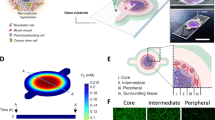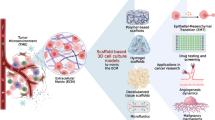Abstract
Three-dimensional (3D) in vitro modeling is increasingly relevant as two-dimensional (2D) cultures have been recognized with limits to recapitulate the complex endogenous conditions in the body. Additionally, fabrication technology is more accessible than ever. Bioprinting, in particular, is an additive manufacturing technique that expands the capabilities of in vitro studies by precisely depositing cells embedded within a 3D biomaterial scaffold that acts as temporary extracellular matrix (ECM). More importantly, bioprinting has vast potential for customization. This allows users to manipulate parameters such as scaffold design, biomaterial selection, and cell types, to create specialized biomimetic 3D systems.
The development of a 3D system is important to recapitulate the bone marrow (BM) microenvironment since this particular organ cannot be mimicked with other methods such as organoids. The 3D system can be used to study the interactions between native BM cells and metastatic breast cancer cells (BCCs). Although not perfect, such a system can recapitulate the BM microenvironment. Mesenchymal stem cells (MSCs), a key population within the BM, are known to communicate with BCCs invading the BM and to aid in their transition into dormancy. Dormant BCCs are cycling quiescent and resistant to chemotherapy, which allows them to survive in the BM to resurge even after decades. These persisting BCCs have been identified as the stem cell subset. These BCCs exhibit self-renewal and can be induced to differentiate. More importantly, this BCC subset can initiate tumor formation, exert chemoresistance, and form gap junction with endogenous BM stroma, including MSCs. The bioprinted model detailed in this chapter creates a MSC-BC stem cell coculture system to study intercellular interactions in a model that is more representative of the endogenous 3D microenvironment than conventional 2D cultures. The method can reliably seed primary BM MSCs and BC stem cells within a bioprinted scaffold fabricated from CELLINK Bioink. Since bioprinting is a highly customizable technique, parameters described in this method (i.e., cell–cell ratio, scaffold dimensions) can easily be altered to serve other applications, including studies on hematopoietic regulation.
Access this chapter
Tax calculation will be finalised at checkout
Purchases are for personal use only
Similar content being viewed by others
References
Birgersdotter A, Sandberg R, Ernberg I (2005) Gene expression perturbation in vitro- a growing case for three-dimensional (3D) culture systems. Semin Cancer Biol 15:405–412
Cukierman E, Pankov R, Yamada KM (2002) Cell interactions with three-dimensional matrices. Curr Opin Cell Biol 14:633–639
Even-Ram S, Yamada KM (2005) Cell migration in 3D matrix. Curr Opin Cell Biol 17:524–532
Yamada KM, Cukierman E (2007) Modeling tissue morphogenesis and cancer in 3D. Cell 130:601–610
Dai X, Ma C, Lan Q, Xu T (2016) 3D bioprinted glioma stem cells for brain tumor model and applications of drug susceptibility. Biofabrication 8:045005
Hakkinen KM, Harunaga JS, Doyle AD, Yamada KM (2011) Direct comparisons of the morphology, migration, cell adhesions, and actin cytoskeleton of fibroblasts in four different three-dimensional extracellular matrices. Tissue Eng Part A 17:713–724
Yu Y, Zhang Y, Martin JA, Ozbolat IT (2013) Evaluation of cell viability and functionality in vessel-like bioprintable cell-laden tubular channels. J Biomech Eng 135:91001
Zhou X, Zhu W, Nowicki M, Miao S, Cui H, Holmes B, Glazer RI, Zhang LG (2016) 3D bioprinting a cell-laden bone matrix for breast cancer metastasis study. ACS Appl Mater Interfaces 8:30017–30026
Guiro K, Arinzeh TL (2015) Bioengineering models for breast cancer research. Breast Cancer 9:57–70
Dababneh AB, Ozbolat IT (2014) Bioprinting technology: a current state-of-the-art review. J Manuf Sci Eng 136:061016
Ingber DE, Mow VC, Butler D, Niklason L, Huard J, Mao J, Yannas I, Kaplan D, Vunjak-Novakovic G (2006) Tissue engineering and developmental biology: going biomimetic. Tissue Eng 12(12):3265–3283
Kasza KE, Rowat AC, Liu J, Angelini TE, Brangwynne CP, Koenderink GH, Weitz DA (2007) The cell as a material. Curr Opin Cell Biol 19:101–107
Steer DL, Nigam SK (2004) Developmental approaches to kidney tissue engineering. Am J Physiol Renal Physiol 286:F1–F7
Derby B (2012) Printing and prototyping of tissues and scaffolds. Science 338(6109):921–926
Marga F, Neagu A, Kosztin I, Forgacs G (2007) Developmental biology and tissue engineering. Birth Defects Res C Embryo Today 81:320–328
Mironov V, Visconti RP, Kasyanov V, Forgacs G, Drake CJ, Markwald RR (2009) Organ printing: tissue spheroids as building blocks. Biomaterials 30:2164–2174
Kelm JM, Lorber V, Snedeker JG, Schmidt D, Broggini-Tenzer A, Weisstanner M, Odermatt B, Mol A, Zünd G, Hoerstrup SP (2010) A novel concept for scaffold-free vessel tissue engineering: self-assembly of microtissue building blocks. J Biotechnol 148:46–55
Skardal A, Zhang J, Prestwich GD (2010) Bioprinting vessel-like constructs using hyaluronan hydrogels crosslinked with tetrahedral polyethylene glycol tetracrylates. Biomaterials 31:6173–6181
Okamoto T, Suzuki T, Yamamoto N (2000) Microarray fabrication with covalent attachment of DNA using bubble jet technology. Nat Biotechnol 18:438–841
Goldmann T, Gonzalez JS (2000) DNA-printing: utilization of a standard inkjet printer for the transfer of nucleic acids to solid supports. J Biochem Biophys Methods 42(3):105–110
Xu T, Jin J, Gregory C, Hickman JJ, Boland T (2005) Inkjet printing of viable mammalian cells. Biomaterials 26(1):93–99
Xu T, Gregory CA, Molnar P, Cui X, Jalota S, Bhaduri SB, Boland T (2006) Viability and electrophysiology of neural cell structures generated by the inkjet printing method. Biomaterials 27(19):3580–3588
Cui X, Boland T, D D'Lima D, K Lotz M (2012) Thermal inkjet printing in tissue engineering and regenerative medicine. Recent Pat Drug Deliv Formul 6(2):149–155
Tekin E, Smith PJ, Schubert US (2008) Inkjet printing as a deposition and patterning tool for polymers and inorganic particles. Soft Matter 4(4):703–713
Fang Y, Frampton JP, Raghavan S, Sabahi-Kaviani R, Luker G, Deng CX, Takayama S (2012) Rapid generation of multiplexed cell cocultures using acoustic droplet ejection followed by aqueous two-phase exclusion patterning. Tissue Eng Part C Methods 18:647–657
Saunders R, Bosworth L, Gough J, Derby B, Reis N (2004) Selective cell delivery for 3D tissue culture and engineering. Eur Cells Mater 7:84–85
Saunders RE, Gough JE, Derby B (2008) Delivery of human fibroblast cells by piezoelectric drop-on-demand inkjet printing. Biomaterials 29:193–203
Nakamura M, Kobayashi A, Takagi F, Watanabe A, Hiruma Y, Ohuchi K, Iwasaki Y, Horie M, Morita I, Takatani S (2005) Biocompatible inkjet printing technique for designed seeding of individual living cells. Tissue Eng 11:1658–1666
Colina M, Serra P, Fernández-Pradas JM, Sevilla L, Morenza JL (2005) DNA deposition through laser induced forward transfer. Biosens Bioelectron 20:1638–1642
Kim JD, Choi JS, Kim BS, Choi YC, Cho YW (2010) Piezoelectric inkjet printing of polymers: stem cell patterning on polymer substrates. Polymer 51:2147–2154
Murphy SV, Skardal A, Atala A (2013) Evaluation of hydrogels for bio-printing applications. J Biomed Mater Res A 101:272–284
Chrisey DB (2000) The power of direct writing. Science 289:879–881
Guillemot F, Souquet A, Catros S, Guillotin B (2010) Laser-assisted cell printing: principle, physical parameters versus cell fate and perspectives in tissue engineering. Nanomedicine 5:507–515
Guillotin B, Souquet A, Catros S, Duocastella M, Pippenger B, Bellance S, Bareille R, Rémy M, Bordenave L, Amédée J (2010) Laser assisted bioprinting of engineered tissue with high cell density and microscale organization. Biomaterials 31:7250–7256
Hopp B, Smausz T, Kresz N, Barna N, Bor Z, Kolozsvári L, Chrisey DB, Szabó A, Nógrádi A (2005) Survival and proliferative ability of various living cell types after laser-induced forward transfer. Tissue Eng 11:1817–1823
Koch L, Kuhn S, Sorg H, Gruene M, Schlie S, Gaebel R, Polchow B, Reimers K, Stoelting S, Ma N (2009) Laser printing of skin cells and human stem cells. Tissue Eng 16:847–854
Kattamis NT, Purnick PE, Weiss R, Arnold CB (2007) Thick film laser induced forward transfer for deposition of thermally and mechanically sensitive materials. Appl Phys Lett 91:171120
Duocastella M, Fernández-Pradas J, Morenza J, Zafra D, Serra P (2010) Novel laser printing technique for miniaturized biosensors preparation. Sensors Actuators B Chem 145:596–600
Chang CC, Boland ED, Williams SK, Hoying JB (2011) Direct-write bioprinting three-dimensional biohybrid systems for future regenerative therapies. J Biomed Mater Res B Appl Biomater 98:160–170
Fedorovich NE, Swennen I, Girones J, Moroni L, Van Blitterswijk CA, Schacht E, Alblas J, Dhert WJ (2009) Evaluation of photocrosslinked lutrol hydrogel for tissue printing applications. Biomacromolecules 10:1689–1696
Chang R, Nam J, Sun W (2008) Effects of dispensing pressure and nozzle diameter on cell survival from solid freeform fabrication–based direct cell writing. Tissue Eng 14:41–48
Smith CM, Stone AL, Parkhill RL, Stewart RL, Simpkins MW, Kachurin AM, Warren WL, Williams SK (2004) Three-dimensional bioassembly tool for generating viable tissue-engineered constructs. Tissue Eng 10:1566–1576
Nair K, Gandhi M, Khalil S, Yan KC, Marcolongo M, Barbee K, Sun W (2009) Characterization of cell viability during bioprinting processes. Biotechnol J 4:1168–1177
Reed EJ, Klumb L, Koobatian M, Viney C (2009) Biomimicry as a route to new materials: what kinds of lessons are useful? Math Phys Eng Sci 367:1571–1585
Huh D, Torisawa YS, Hamilton GA, Kim HJ, Ingber DE (2012) Microengineered physiological biomimicry: organs-on-chips. Lab Chip 12:2156–2164
Hospodiuk M, Dey M, Sosnoski D, Ozbolat IT (2017) The bioink: a comprehensive review on bioprintable materials. Biotechnol Adv 35:217–239
Haycock JW (2011) 3D cell culture: a review of current approaches and techniques. Methods Mol Biol 695:1–15
Ambesi-Impiombato F, Parks L, Coon H (1980) Culture of hormone-dependent functional epithelial cells from rat thyroids. Proc Natl Acad Sci 77:3455–3459
Blaeser A, Duarte Campos DF, Puster U, Richtering W, Stevens MM, Fischer H (2016) Controlling shear stress in 3D bioprinting is a key factor to balance printing resolution and stem cell integrity. Adv Healthc Mater 5:326–333
Ozbolat IT, Yu Y (2013) Bioprinting toward organ fabrication: challenges and future trends. IEEE Trans Biomed Eng 60:691–699
Pittenger MF, Mackay AM, Beck SC, Jaiswal RK, Douglas R, Mosca JD, Moorman MA, Simonetti DW, Craig S, Marshak DR (1999) Multilineage potential of adult human mesenchymal stem cells. Science 284:143–147
Li J, Chi J, Liu J, Gao C, Wang K, Shan T, Li Y, Shang W, Gu F (2017) 3D printed gelatin-alginate bioactive scaffolds combined with mice bone marrow mesenchymal stem cells: a biocompatibility study. Int J Clin Exp Pathol 10:6299–6307
Patel SA, Ramkissoon SH, Bryan M, Pliner LF, Dontu G, Patel PS, Amiri S, Pine SR, Rameshwar P (2012) Delineation of breast cancer cell hierarchy identifies the subset responsible for dormancy. Sci Rep 2:906
Corcoran KE, Trzaska KA, Fernandes H, Bryan M, Taborga M, Srinivas V, Packman K, Patel PS, Rameshwar P (2008) Mesenchymal stem cells in early entry of breast cancer into bone marrow. PLoS One 3:e2563
Bliss SA, Sinha G, Sandiford OA, Williams L, Engelberth DJ, Guiro K, IL L, Greco SJ, Ayer S, Bryan M, Kumar R, Ponzio NM, Rameshwar P (2016) Mesenchymal stem cell-derived exosomes stimulates cycling quiescence and early breast cancer dormancy in bone marrow. Cancer Res 76:1–13
Acknowledgment
In partial fulfillment for a Ph.D. by CAM. This work is supported by a grant awarded by F.M Kirby Foundation.
Author information
Authors and Affiliations
Corresponding author
Editor information
Editors and Affiliations
Rights and permissions
Copyright information
© 2018 Springer Science+Business Media, LLC, part of Springer Nature
About this protocol
Cite this protocol
Moore, C.A., Shah, N.N., Smith, C.P., Rameshwar, P. (2018). 3D Bioprinting and Stem Cells. In: Singh, S., Rameshwar, P. (eds) Somatic Stem Cells. Methods in Molecular Biology, vol 1842. Humana Press, New York, NY. https://doi.org/10.1007/978-1-4939-8697-2_7
Download citation
DOI: https://doi.org/10.1007/978-1-4939-8697-2_7
Published:
Publisher Name: Humana Press, New York, NY
Print ISBN: 978-1-4939-8696-5
Online ISBN: 978-1-4939-8697-2
eBook Packages: Springer Protocols




